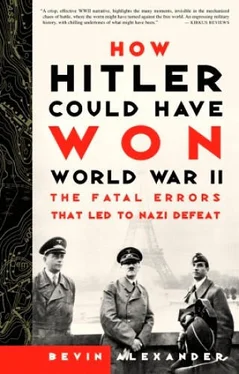Churchill was willing to play down British participation, but said Algiers—the biggest city and nerve center of French North Africa— should be occupied the same time as Oran and Casablanca. FDR and Churchill finally agreed to joint American-British landings at Algiers simultaneous with the others.
But in the exchanges, the idea of landings farther east was dropped— killing any chance for a quick Allied victory in North Africa and prolonging the diversion of Allied effort in the Mediterranean.
In the final plan, the Western Task Force, guarded by U.S. Navy ships with 24,500 Americans under Major General George S. Patton Jr., was to land at Casablanca. The 102 ships (29 transports) sailed directly from Hampton Roads, Virginia. Center Task Force, protected by the Royal Navy with 18,500 American troops under Major General Lloyd R. Fredenall, was to capture Oran. It sailed from the Firth of Clyde in Scotland. Eastern Task Force, also sailing from the Clyde and guarded by the Royal Navy with 9,000 British and 9,000 American troops, plus 2,000 British Commandos under American Major General Charles W. (Doc) Ryder, was to land at Algiers. Once ashore all Allied forces at Algiers were to come under a newly created British First Army commanded by Lieutenant General Kenneth A. Anderson and drive toward Tunisia.

Americans and Britons landed in North Africa on November 8, a couple weeks after General Montgomery’s 8th Army finally attacked Rommel’s weak and poorly supplied army at El Alamein. Resistance by the French army was symbolic in most cases, though not all, and the French air force was nowhere to be seen. But the French navy defended itself strongly.
The solely American landings of George Patton’s Western Task Force took place in three points on the Moroccan Atlantic coast: a main effort at Fedala, fifteen miles north of Casablanca; and subsidiary ones at Mehdia, fifty-five miles farther north; and at Safi, 140 miles south of Casablanca. Fedala was the nearest landing beach to Casablanca, the only large and well-equipped harbor in this part of Africa. Mehdia was the closest beach to Port Lyautey, whose airfield had the sole concrete runway in Morocco. Safi served to guard against intervention by a large French garrison at inland Marrakech, and also had a port where medium tanks could be unloaded. The new LSTs (Landing Ships Tanks) now being produced were not ready for Torch.
French army resistance was insignificant at Fedala and Safi, and by the afternoon of November 8, the Americans had attained their goals. Only at Mehdia did French troops resist strongly. Fighting ceased on November 11 after the senior French officer in North Africa, Admiral François Darlan, signed a cease-fire.
However, a sea fight broke out north of Casablanca at 7:04 A.M., November 8, between the American battleship Massachusetts and two French heavy cruisers, coastal batteries, and the battleship Jean Bart, which lay immobile in Casablanca harbor. American gunfire destroyed the main artillery batteries of the battleship. Other American warships warded off an attempted attack on troop transports by a French light cruiser and eight destroyers. Only one French ship returned undamaged, but the French made heavy hits on American warships.
The landings of the Center Task Force at Oran and the Eastern Task Force at Algiers took place with little resistance.
Eisenhower’s principal goal was to assemble his troops, build a supply line, and advance on Tunis, in hopes of getting there before the Germans. But the Atlas Mountains of eastern Algeria proved difficult, and bringing forward supplies a great problem. Now the extreme caution of the Americans in refusing to land closer to Tunisia began to exact its toll.
The German navy had held since 1940 that Tunisia was the key position in the Mediterranean—because it dominated Axis traffic routes to Africa and was an ideal base from which to invade Sicily and mainland Italy. The navy believed the Allies would try to seize Tunisia at the first opportunity.
The Axis had ample warning. The German foreign office was flooded with news, much of it dead on target. A report from the Vatican, for example, pinpointed the landings and said they would take place between mid-October and mid-November. A failed British-Canadian raid on Dieppe, France, on August 19 gave an even more certain sign. It showed that no landing would be made on the Continent in 1942, and this turned the arrow on French North Africa.
Adolf Hitler did nothing to prepare for the expected invasion. But, once it came, he moved fast, though not in great force, to hold a bridgehead in Tunisia. On the morning of November 9 he gave Albert Kesselring, German commander in the Mediterranean, a free hand, and the same day Kesselring sent in one fighter and two Stuka groups, and parts of the 5th Parachute Regiment, to occupy the Tunis airport, and, on the night of November 12, the city of Tunis.
Hitler also marched into unoccupied France and seized the French island of Corsica. The move (Operation Anton) began on November 11 and was finished in three days. The shock this gave did much to swing French officers in North Africa to the Allied side. The Germans did not immediately advance into the harbor of Toulon, where the vast bulk of the remaining French fleet lay at anchor. They hoped they could keep the fleet for Axis use, while Admiral Darlan was trying, without success, to get it to move to North Africa. On November 27, after having mined the harbor exits, German troops pressed into the base with the aim of seizing the ships. The French crews scuttled the entire fleet, including the battleship Strasbourg, before the eyes of the Germans.
General Walther Nehring, former commander of Africa Corps, took charge in Tunisia on November 15 as commander of 90th Corps, though he had only about 3,000 troops. Without waiting to concentrate, he thrust westward. The French division in Tunisia, under General George Barré, though much stronger, pulled back toward Algeria, hoping to join the Allies before clashing with the Germans.
General Anderson sent a British force to capture the port of Bougie, 110 miles east of Algiers, on November 11, and the next day seized the harbor and airfield of Bône, sixty miles from the Tunisian border. Coastal convoys began running in supplies and troops to both ports.
Anderson sent the British 78th and 6th Armored Divisions to take Tunisia. One part reached Djebel Abiod, fifty miles west of Bizerte, on November 17, where it collided with a small German parachute engineer battalion under Major Rudolf Witzig, the same officer who had seized Belgium’s fort Eben Emael in 1940. Another British force seized Tabarka, a few miles west. The day previously a British paratroop battalion took Souk el Arba, south of Tabarka and eighty miles from Tunis. Meanwhile the American 509th Parachute Battalion landed near Tébessa, close to the Tunisian border, to cover the southern flank and secure an airfield there. Two days later it made an eighty-mile bound southeast and seized Gafsa, only seventy miles from the Gulf of Gabès.
General Anderson delayed his advance to consolidate his forces, giving the Germans a chance to expand the bridgehead. On November 17, a German parachute battalion of 300 men under Captain Walter Koch pushed westward, against a French force under General Barré that withdrew to the road center of Medjez el Bab, thirty-five miles west of Tunis, with an important bridge over the Medjerda River. There the French were reinforced by a British parachute battalion and an American artillery battalion.
General Barré received an ultimatum to withdraw to the Algerian border. It was quite a bluff by Captain Koch, for he had only one-tenth the troops of the Allies. When Barré tried to play for time, the Germans opened fire. Soon afterward Stukas bombed the Allied positions, shaking up the defenders and adding weight to the deception. The German paratroopers made two small but noisy ground attacks, which gave an exaggerated idea of strength, then small parties swam the river and simulated an even bigger attack. It was too much for the Allies. They left the bridge undamaged and fled eight miles to the rear.
Читать дальше



![Джонатан Димблби - Barbarossa - How Hitler Lost the War [calibre]](/books/385421/dzhonatan-dimblbi-barbarossa-how-hitler-lost-the-w-thumb.webp)









